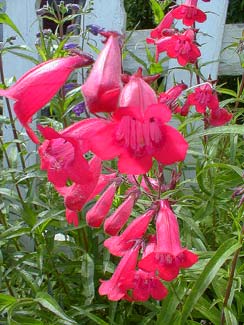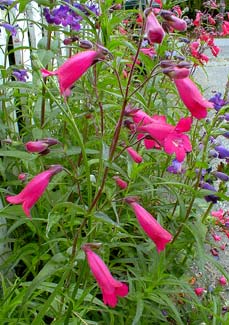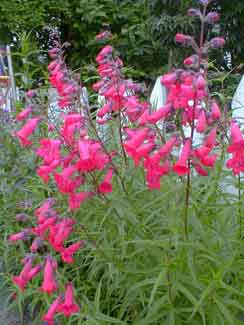
'Ruby' Bearded Tongue
aka 'Schoenholzeri' Beardtongue
aka 'Firebird' Border Penstemon
"Beloved, thou hast brought me many flowers
Plucked in the garden."
-Elizabeth Barrett Browning
(1806‚1861)
(1806‚1861)
Obtained labeled Penstemon 'Ruby' this is sometimes offered as 'Firebird.' However, it is in actuality more properly called 'Schoenholzeri' after Swiss grower Paul Schoenholzer who released this variety in 1939.
It was a cross between the hardy 'Andenken an Friedrick Hahn' (aka 'Garnet') & the comparatively delicate 'Southgate Gem.' We have 'Garnet' growing in the same row of penstemons. 'Garnet' is a purer red with marginally smaller blooms, while 'Ruby' has a degree of purple in its make-up, darkening the red. But ultimately both 'Garnet' & 'Ruby' look an awful lot alike.
 The name change from 'Schoenholzeri' to 'Ruby' seems to have occurred merely to have an easily pronouncable name for the English-speaking nursery trade, but lends some confusion since other red penstemons also get called 'Ruby,' hence the additional alternative 'Firebird.'
The name change from 'Schoenholzeri' to 'Ruby' seems to have occurred merely to have an easily pronouncable name for the English-speaking nursery trade, but lends some confusion since other red penstemons also get called 'Ruby,' hence the additional alternative 'Firebird.' This 'Ruby,' a recipient of the Award of Garden Merit, has vivid scarlet flowers with red-striped white throats summer & autumn, on stems over two feet tall.
It likes a somewhat dry location to discourage root-rot, & would prefer not to be fertilized. As with other penstemons, deadheading prolongs the blooms past August, but toward the end of its long bloom period it can be permitted to go to seed, for it might self-seed, as it will otherwise die out of the garden in a few years.
 Sometimes, once a spent clump has approached three feet wide & is no longer blooming its best, division into smaller clumps might refresh it. However, penstemons often resent being dug up & take overlong to recover. It is more certain to result in happy outcomes if autumn cuttings can be rooted indoors through the winter then placed in the garden come spring, replacing entirely any plants that no longer perform well.
Sometimes, once a spent clump has approached three feet wide & is no longer blooming its best, division into smaller clumps might refresh it. However, penstemons often resent being dug up & take overlong to recover. It is more certain to result in happy outcomes if autumn cuttings can be rooted indoors through the winter then placed in the garden come spring, replacing entirely any plants that no longer perform well.It is often recommended to cut penstemons nearly to the ground after heavy bloom, & perhaps this is a very good idea further north. But here on Puget Sound, that would be much too soon.
I love their lasting evergreen presence when the autumn blooms are done. 'Ruby' has very striking winter foliage, with the appearance of a densely leafed shrub, the leaves delicately red-veined & the leaf stems reddish as well. So I would not cut this lovely subshrub back until very late in winter.
Wild penstemons are native to North America. Native Americans used penstemons medicinally, packing mashed leaves into tooth caries to relieve pain, to treat rattlesnake bite or small wounds, to hasten expulsion of afterbirth, in treatment of venereal diseases, or steeped the leaves in boiling water to use as eyewash or tonic tea.
These traditional claims for its value have been investigated by modern science & found to have a degree of validity. Penstemon species contain sundry glucocides including the chemical catalpol, found also in Rehmannia & Plantago & similar potent herbs. But some of its glucocides are toxic in order to discourage insect & mammal browsing of leaves, so can be harmful to humans, & can interfer with the effectiveness of prescription medicines.
Penstemon x gloxinioides 'Apple Blossom'